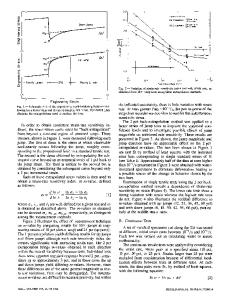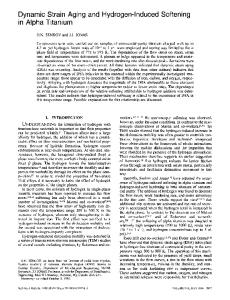Thermal and strain rate softening in Al-Mg sheet during necking and shear band formation
- PDF / 276,764 Bytes
- 3 Pages / 597 x 774 pts Page_size
- 4 Downloads / 404 Views
g~.,~-_
o.o 7
/ o
o J
104
~
Q: k.. 0.7
n
Q ,..j u.i
103
0.9
Q: 11. 0
0
I0 2 I
I
I
4O
5O
60
ATOM PCT. Mg in Ag
Fig. 1--Compressiveyield stress (psi) vs atom percent of Mg in Ag for various homologoustemperatureswhose values are indicated and range between 0.07 and 0.9. behavior at about the 50 at. pct stoichiometric point. While this does not of itself constitute proof of the tentative explanation advanced by Westbrook 4 for the observed behavior, it is at least worth reporting since compression yield stress may be a more useful parameter for applications than is hardness.
REFERENCES 1. A.J. Bradley and A. Taylor: Phil. Mag., 1937, vol. 23, pp. 1049-52. 2. A.J. Bradley and A. Taylor: Proc. Roy. Soc., 1938, vol. 166, pp. 353-56. 3. A. Taylor and N. J. Doyle: J. Appl. Cryst., 1972, vol. 5, pp. 201-03. 4. J. H. Westbrook: J. Electrochemical Soc., 1957, vol. 104, pp. 369-73.
Thermal and Strain Rate Softening in AI-Mg Sheet during Necking and Shear Band Formation
ing. ~Thermal softening during plastic flow is thought to be a factor promoting flow localization into shear bands during torsion testing, 2'3'4 forging, 4'5'6 high speed metal removal, 4'7 and projectile penetration. 7-]~ Recent experiments have shown that shear bands can grow across the dimensions of a deforming aluminum alloy sample under conditions in which there should be little thermal softening. 12''3 The purpose of this work is to estimate separately the magnitude of flow stress reduction resulting from temperature rise and from changing strain rate during these experiments. It will be shown that the magnitude of thermal softening is less than 1 pct of that arising from increasing strain rate. The sheet material used in this study is a commercially produced (5182-O) A1-4.4 pct Mg-0.4 pct Mn alloy. Sheet test specimens were extended under conditions of plane strain flow by impressing rigid indenters into the reduced section of a test coupon prior to testing. The test fixture and specimen are shown elsewhere. ~4,15The constrained sample was extended in an Instron test machine at an initial strain rate of either 3 • l 0 -4 S-] or 3 • 10-2 s -l. The slower rate is the standard rate used in previous experimental studies of shear band formation. 12-14'16A thermocouple was spot welded onto the polished sheet surface of an undeformed specimen at the location where localized necking developed during testing. The positive lead wire of the thermocouple was spot welded to one sheet surface and the negative lead wire to the other sheet surface as shown in Figure 1. Since the sheet itself formed the thermocouple junction, the measured temperature came from the region of sheet between the wires. The experimental technique takes advantage of the principle that insertion of any piece of metal into the thermocouple circuit will not affect the electromotive force provided that the temperatures of the two junctions on the metal body are the same.17 The response of the temperature measuring system was found by experiment to be 230 ~ s -l. Figure 2 show
Data Loading...











